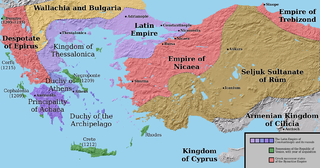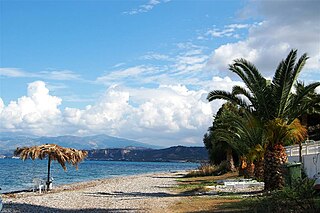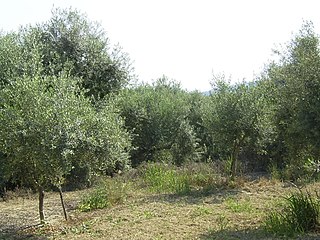Related Research Articles

The Principality of Achaea or Principality of Morea was one of the three vassal states of the Latin Empire, which replaced the Byzantine Empire after the capture of Constantinople during the Fourth Crusade. It became a vassal of the Kingdom of Thessalonica, along with the Duchy of Athens, until Thessalonica was captured by Theodore, the despot of Epirus, in 1224. After this, Achaea became for a while the dominant power in Greece.

The Battle of Pelagonia or Battle of Kastoria took place in early summer or autumn 1259, between the Empire of Nicaea and an anti-Nicaean alliance comprising Despotate of Epirus, Sicily and the Principality of Achaea. It was a decisive event in the history of the Eastern Mediterranean, ensuring the eventual reconquest of Constantinople and the end of the Latin Empire in 1261.

Alissos is a village and a community in the municipal unit of Dymi, Achaea, Greece. It is located near the Gulf of Patras, 3 km east of Kato Achaia, 3 km southwest of Kaminia and 17 km southwest of Patras. The community consists of the villages Alissos, Kamenitsa, Paralia Alissou and Profitis Elissaios. The Greek National Road 9 and the railway from Patras to Pyrgos run between Alissos and Paralia Alissou.

The Battle of the Olive Grove of Kountouras took place in the summer of 1205, in Messenia in the Morea peninsula, between the Frankish Crusaders and the local Byzantine Greeks, resulting in a victory of the Franks and the collapse of the local resistance.

Skorta was a name used in the 13th and 14th centuries, during the period of Frankish rule in the Peloponnese, to designate the mountainous western half of the region of Arcadia, which separated the coastal plains of the western (Elisian) and southwestern (Messinian) Peloponnese from the Arcadian plateau in the interior. The name is found chiefly in the various-language editions of the Chronicle of the Morea. It also appears as Skodra and Skorda, in the chronicle of Pseudo-Dorotheos of Monemvasia.

Philip I, known as Philip of Savoy was the lord of Piedmont from 1282 until his death and prince of Achaea between 1301 and 1307. He was the son of Thomas III of Piedmont and Guyonne de Châlon.
Nicholas II of Saint Omer was the lord of half of Thebes in Frankish Greece from 1258 to his death in 1294. From his two marriages he became one of the richest and most powerful barons of his time, building a splendid castle at Thebes as well as the Old Navarino castle. He also served as bailli of the Principality of Achaea on behalf of the Angevins of Naples between 1287 and 1289.

Araklovon, rarely known with the variant Oreoklovon (Ὀρεόκλοβον) and in French as Bucelet and variants thereof, was a medieval castle of the Byzantine era located in the region of Skorta in the southwestern Peloponnese in Greece.

The Barony of Akova was a medieval Frankish fiefdom of the Principality of Achaea, located in the mountains of eastern Elis in the Peloponnese peninsula in Greece, centred on the fortress of Akova or Mattegrifon. It was among the twelve original baronies of Achaea, but was conquered by the Byzantines in 1320.

The Barony of Passavant or Passava was a medieval Frankish fiefdom of the Principality of Achaea, located in the mountains between the Mani peninsula and the plain of Laconia, in the Peloponnese peninsula in Greece, centred on the fortress of Passavant or Passava. It was among the twelve original baronies of the Principality of Achaea, but was conquered by the Byzantines in the early 1260s.

The Barony of Kalavryta was a medieval Frankish fiefdom of the Principality of Achaea, located in the Peloponnese peninsula in Greece, centred on the town of Kalavryta.

The Barony of Karytaina or of Skorta was a medieval Frankish fiefdom of the Principality of Achaea, located in the Peloponnese peninsula in Greece, centred on the town of Karytaina in the mountainous region known as Skorta.

The Barony of Arcadia was a medieval Frankish fiefdom of the Principality of Achaea, located on the western coast of the Peloponnese peninsula in Greece, and centred on the town of Arcadia, ancient and modern Kyparissia.

The Barony of Estamira or Stamira was a medieval Frankish fiefdom of the Principality of Achaea, located in the fertile plains of the Elis region of the Peloponnese peninsula in Greece, and centred on the now vanished fortress of Estamira.
Geoffrey of Briel, in older literature Geoffrey of Bruyères, was a French knight and the third lord of the Barony of Karytaina in the Principality of Achaea, in Frankish Greece. He led a colourful and turbulent life, narrated in detail in the Chronicle of the Morea. Accounted the finest knight in the Principality, he fought in the wars against the Byzantine Greeks, was captured in the Battle of Pelagonia in 1259, and was sent back to Achaea bearing the Byzantine terms in 1261. Geoffrey was twice deprived of his barony, once for rebelling against his uncle, the Prince of Achaea William II of Villehardouin, and then for abandoning the Principality without leave in order to spend time with a mistress, the wife of one of his feudatories, in Italy. He was pardoned both times, but henceforth held his title as a gift of the Prince. He died childless in 1275, and the Barony of Karytaina was split up.

The Battle of Picotin was fought on 22 February 1316 between the Catalan forces of the infante Ferdinand of Majorca, claimant to the Principality of Achaea, and the forces loyal to Princess Matilda of Hainaut, comprising native levies from the barons loyal to the Princess as well as Burgundian knights. The battle ended in a crushing victory for Ferdinand, but he was later engaged and killed by the troops of Matilda's husband, Louis of Burgundy, at the Battle of Manolada.
Hugh of Briel, in older literature Hugh of Bruyères, was a French knight and the second lord of the Barony of Karytaina in the Principality of Achaea, in Frankish Greece.
Margaret of Nully also known as Margaret of Passavant, was the hereditary Lady of Passavant, Akova and Mitopoli in the Principality of Achaea, in Frankish Greece.
Renaud of Briel, in older literature Renaud of Bruyères, was a French knight and the first lord of the Barony of Karytaina in the Principality of Achaea, in Frankish Greece.

The Battle of Saint George took place on 9 September 1320 between the Latin Principality of Achaea and the forces of the Byzantine governor of Mystras, at the fortress of Saint George in Skorta in Arcadia. As a result of the battle, Arcadia, the heartland of the Morea, came firmly under Byzantine control.